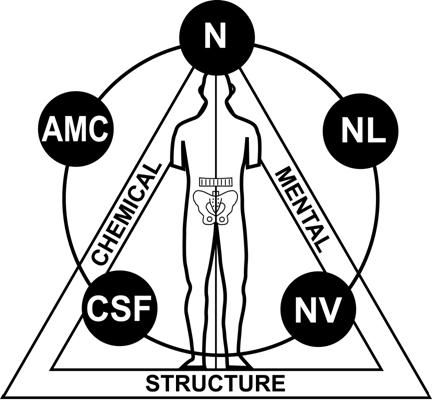AK EXPLAINED - PART 2
- Dr. Cullyn Consales
- Jun 10, 2016
- 2 min read

In the previous post I briefly mentioned what is called the triad of health, depicted below. Located within the diagram is an equilateral triangle illustrating the three primary stressors which affect your body’s function, structure, chemical, and mental. It is important to note that this is an equilateral triangle, each is equally important. The outer portion of the triangle shows the various modalities which can be utilized to treat each specific stressor.
THE THREE THINGS THAT MAKE YOU SICK
The interaction between the three sides of the triad of health, is an important and very useful principle in Applied Kinesiology evaluation. Some examples of how one side of the triad affect another side are well known. For example, certain foods or chemicals may cause mental disturbances. Fear, mental, causes the release of adrenaline, chemical, which increases the tension in skeletal muscles, structural. Tension in the neck, structural, may cause severe headaches and depression, mental. Emotional problems, mental, may cause headache if the cause is primarily nutritional.
To pictorially illustrate this point, if as a doctor, the only tool one has is a hammer, the only problem you see is a nail. This unfortunately, the primary downfall of currently popular specialized medical approach which aims to correct chronic conditions.
When a health problem exists for an extended period of time and becomes chronic, all three sides of the triad of health usually become involved. Therefore, the problem that brings a patient to a therapist is often not the primary problem at all, but rather a reaction on another side of the triad. As long as the primary problem is not diagnosed and treated the same symptoms will return or other secondary problems may emerge.
It is important to note that each of these three stressors are cumulative and everybody’s body has a certain about of stress which it can handle before a symptom develops. Each if these stressors, thought the day, build up and up and up until the body can no longer function properly. It is a this point that you develop a symptom.
If these stressors are not properly removed the symptoms will get worse and many times multiply. A symptom is nothing more than an alarm going off in the body. It’s your body saying “help! help! I’m not working right!” It never tells you what the problem is or where it is coming from. Most of the time, patients with the same symptoms require very different therapies. Since muscle testing uses your body itself as the instrument for performing diagnostics and determining treatment, it provides a direct method individualized method for correction.



Comments